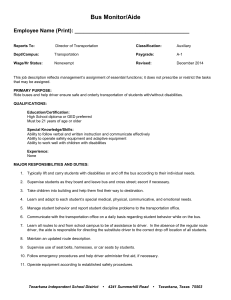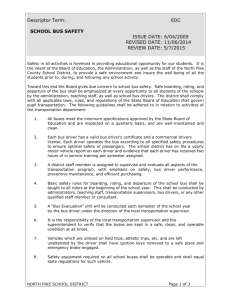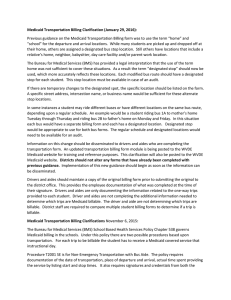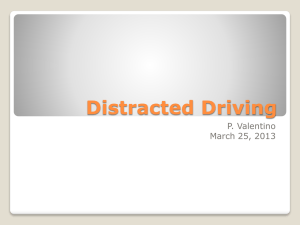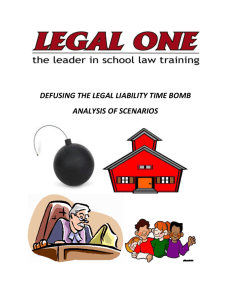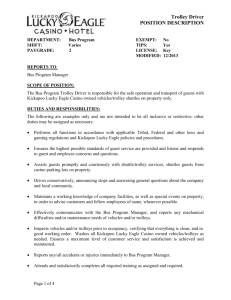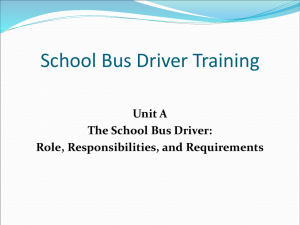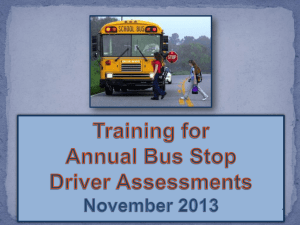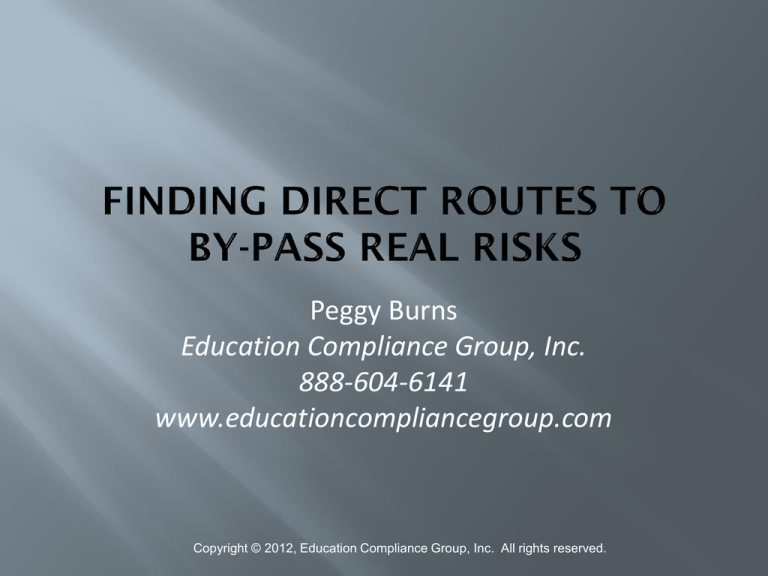
Peggy Burns
Education Compliance Group, Inc.
888-604-6141
www.educationcompliancegroup.com
Copyright © 2012, Education Compliance Group, Inc. All rights reserved.
Avoiding some risks requires concerted effort by
everyone involved: Coordination, role delineation,
investigation, and follow-up
District and school personnel must provide the
information you need
Drivers and attendants must act when necessary
Transportation administrators must establish and
communicate clear rules; drivers and attendants must
follow them
Transportation administrators must train and enforce;
remain knowledgeable and monitor; build bridges
based on firm foundations
•
•
•
Is there reason to know
harm is likely?
Did the school district or
the company do anything
to increase the harm?
Were available options
explored?
Information sources
Complying with IEP
Complying with contract
Choices within your authority
“Why didn’t the bus driver know any of this?”
Were there clues and signals?
Is there knowledge of immediate or imminent
threat?
Was there an interval in which preventive measures
could have been taken before the harmful action
occurred
Did the driver have available options for action?
Issues in dispute
Who makes what
decisions, and why?
Seclusion and restraint
Where and how?
To “Aide” or not to “Aide”
The LRE/ Safety Balance
I.R. is a 12-year old who has a rare condition,
rendering him legally blind, and poorly developed,
with fragile bones. The district has shared no
information with the bus contractor – including
the boy’s vulnerability to serious injury.
The bus company typically conducts evacuation
drills.
I.R. is made to participate in a drill, and is severely
hurt.
Were there opportunities to prevent the harm to
the student?
How did it get to this
point?
What don’t we/
didn’t we know?
Why didn’t we know
it?
How could we avoid
getting to this point?
Contractor transports student with impaired motor
function. In the past, she has been allowed to walk
up the bus stairs with guidance from aide or driver
In the course of looking into a complaint about the
aide, district’s PT determines the student is not
physically able to use the bus steps
Mom wants student to ride motorized scooter up
the lift, and then be transferred to bus seat
Mom has refused district request for OT/PT eval
of student, or provision of input from student’s
personal PT
Mom has started videotaping loading and
unloading of student
Student videotapes on the bus
What mom really wants is for student to walk
up and down bus stairs, and claims failure to
permit this is discrimination and retaliation
There’s active blog commentary about the
situation, and it has been brought to the
attention of a local news agency.
Mom has threatened to sue everyone.
Services to be provided
Who is to provide the services
When the services are to be provided
The procedures for providing such services,
including communication and training for
service providers to ensure and obtain
clarification of their responsibilities
Documentation showing the service providers
have received this information (follow-up)
Driver or monitor’s failure to make search a
part of every post-trip
Staff member’s violation of clear directives
endanger a child
“Zero tolerance” must have real meaning
A child complains about another child hitting her.
The driver forces the child off the bus.
A 4-year old is placed on the wrong bus during
the first 3 weeks of school. Contrary to policy, a
district employee drives her home.
A driver offers “customer service,” and drops
child off at an undesignated bus stop
A boy realizes he’s on the wrong bus, and notifies
the driver. The driver drops him off in front of a
bar, and 3 miles from home.
A substitute driver drops a student on the wrong
side of street. She is killed as a direct result of this
action.
Careless securement of a child with a disability
results in injury to the child.
Inaction where action is needed
Doing nothing is never the right thing
You’re not expected to be a hero, or
even to “fix” the problem
Re-inventing the rules
Stops
Schedules
Seating
Securement
Driver of Iranian origin asserts termination based
on national origin discrimination, despite evidence
that his performance had become problematic.
Driver asserts his former district refused to
accommodate kidney condition in violation of ADA
– wants shorter route.
Part-time driver says district terminated her for toofrequent absences in violation of FMLA’s “return to
work” provision.
Contractor made reasonable attempts to resolve
conflict due to driver’s religious obligations
Will stray remarks come back to haunt you?
Was the employee:
A member of a minority?
Did a “bad thing” happen?
Did it happen to others who did the same thing under the
same circumstances?
Has management failed to take action in the face of
considerable intimidation, ridicule and insult directed against
the employee? How many incidents, over what period of
time, and what has the district or company done or not done
about it? Has it impacted employee’s performance?
Protected activity +
Timing of adverse employment action –
Prior documented issues =
Potential for a retaliation claim
Is there a legitimate nondiscriminatory reason
for the adverse action?
If poor performer, is s/he being treated like
other poor performers, without regard to the
protected activity?
Is there a documented, demonstrated lack of
satisfactory performance, or failure to improve
after a reasonable remediation plan?
How long has it been since the protected activity
took place?
If you haven’t disciplined or negatively evaluated an
employee before s/he exercises legally protected
rights, his or her complaint, grievance, claim or
other assertion of rights is not the time to start.
If adverse action is necessary, be sure your
documentation is in order, and
Illustrates the conduct at issue
Offers clear evidence as to when the conduct
occurred
Presents a sound basis for your response
Supports consistency of response
Why should you take each step?
What does it look like?
Exchanging information
Establishing and communicating clear rules
Instituting interim measures
Monitoring progress and results
When
By whom
Who needs to know?
Resolving inconsistencies
Drawing conclusions
Communicate – Ensure your staff knows when to
inform you before the matter blows up
Be responsive – A timely response can help prevent
situations from escalating
Listen and avoid being defensive – even though it may
not be what you want to hear, approach the incident
with an open mind. You know we’re not always right!
Be honest – If this were happening to your child, how
would you feel? If you’re wrong, say so; if you don’t
have an answer, say so; if you say you’ll do something,
do it.
Follow-through – Monitor the situation to ensure the
incident does not re-occur
Cross-training for employees
Documenting concerns
Ensuring necessary coordination is in place
Listening with an open mind
Hearing the real issue
Accountability and consequences
PO Box 221
Lafayette, CO 80026
888.604.6141
www.educationcompliancegroup.com

